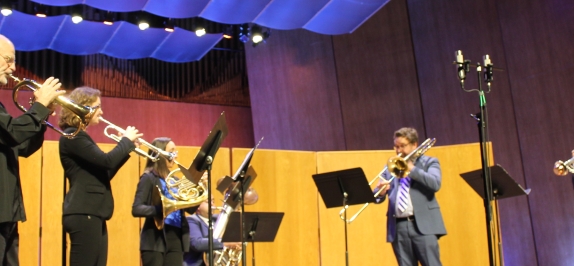
Sokratis Anthis at the University of Kentucky
Greek trumpeter Sokratis Anthis was a guest artist at the University of Kentucky (UK) March 18–21, 2024.
MORE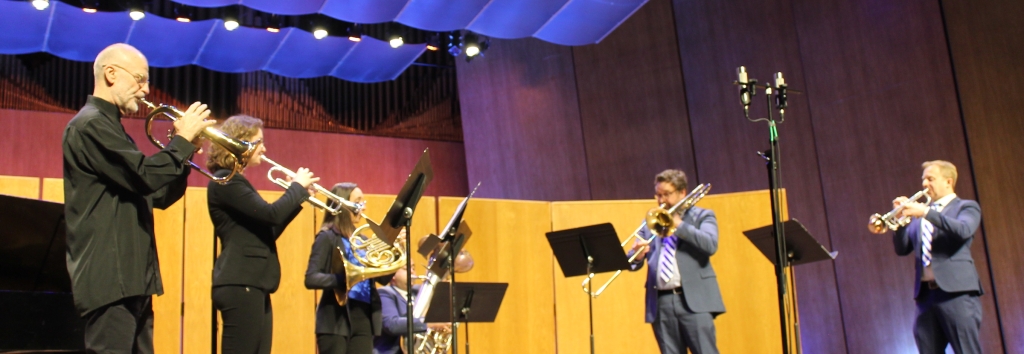

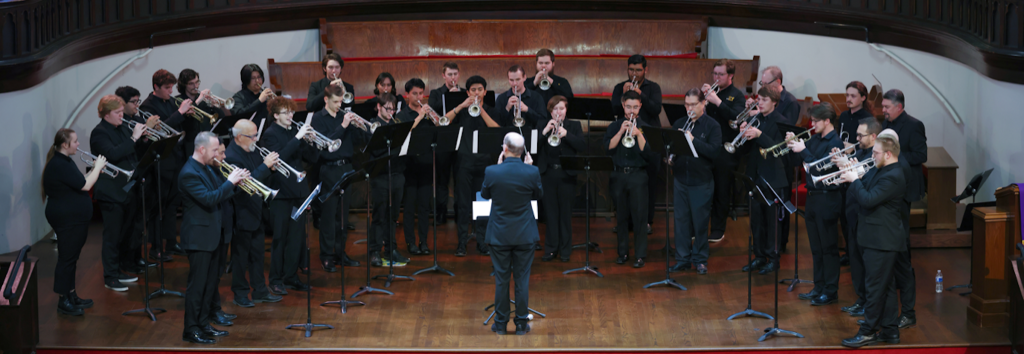

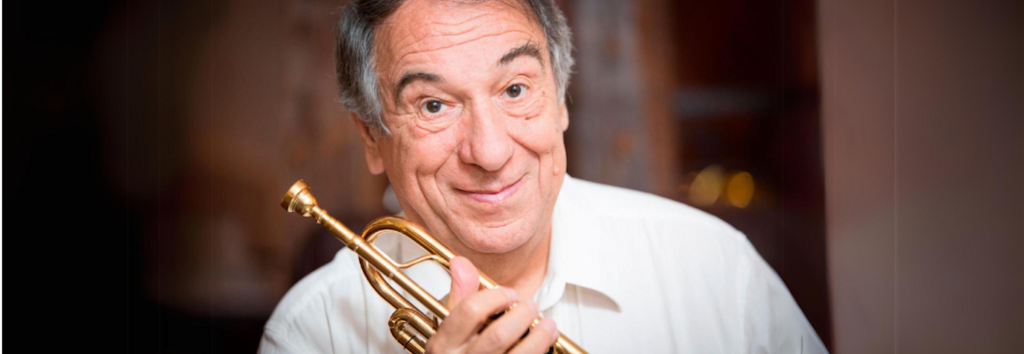


Greek trumpeter Sokratis Anthis was a guest artist at the University of Kentucky (UK) March 18–21, 2024.
MORE
The International Trumpet Guild is pleased to announce an extension for the 2024 Ellsworth Smith Solo Trumpet Competition. The deadline for registration is now May 15, 2024. Any questions may be directed to [email protected].
MORE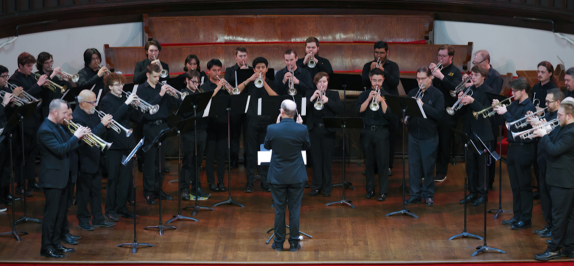
The splendid sounds of the trumpet filled the sanctuary of the First Presbyterian Church of San Angelo on Sunday, February 25 as the Lone Star State Trumpet Guild presented “Music for Trumpets Across the Centuries.”
MOREOn March 31, 2012, the Ohio Chapter of the International Trumpet Guild held its annual OITG meeting on the campus of Miami University in Oxford, OH, attracting close to two hundred players, teachers and enthusiasts, and thirteen exhibitors. The one-day event was hosted by James Olcott, professor of trumpet at Miami University, and featured guest artists Stephen Burns and Carl Saunders.
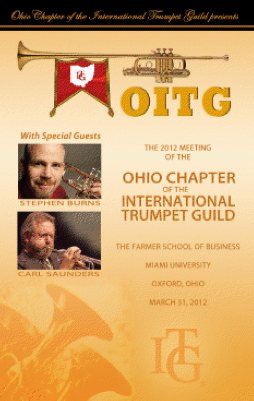 The welcoming ceremony opened with the premiere of An Olcott Overture! dedicated to OITG2012 host Olcott by its composer, Eric Ewazen, and played by the twelve-member Miami University Trumpet Ensemble. After welcoming messages from Olcott, university officials, and ITG vice president Alan Siebert, the Festival of Trumpets commenced, featuring eight collegiate trumpet ensembles from around the region that performed repertoire of their own choosing in addition to premieres taken from a set of fanfares especially commissioned by Olcott to “commemorate OITG2012 and celebrate the trumpet and ITG.” The project, called the OITG 2012 Fanfare Project, involved commissioning nine of Olcott’s favorite composers for trumpet ensemble to each write a fanfare for an ensemble of six B-flat trumpets or flugelhorns at an easy college level in difficulty, with a playing time of ninety seconds. The composers included Robert Bradshaw, Barry Ford, Michael Galib, Jack N. Kimmell, Erik Morales, Clint Needham, Greg Pascuzzi, David Shaffer, and James Stephenson. Of the resulting product Olcott stated, “The diversity in styles between the composers was fascinating.” The ninety members of all the trumpet ensembles combined surrounded the audience as they performed the final piece of the concert, David Shaffer’s Cincinnatus Fanfare.
The welcoming ceremony opened with the premiere of An Olcott Overture! dedicated to OITG2012 host Olcott by its composer, Eric Ewazen, and played by the twelve-member Miami University Trumpet Ensemble. After welcoming messages from Olcott, university officials, and ITG vice president Alan Siebert, the Festival of Trumpets commenced, featuring eight collegiate trumpet ensembles from around the region that performed repertoire of their own choosing in addition to premieres taken from a set of fanfares especially commissioned by Olcott to “commemorate OITG2012 and celebrate the trumpet and ITG.” The project, called the OITG 2012 Fanfare Project, involved commissioning nine of Olcott’s favorite composers for trumpet ensemble to each write a fanfare for an ensemble of six B-flat trumpets or flugelhorns at an easy college level in difficulty, with a playing time of ninety seconds. The composers included Robert Bradshaw, Barry Ford, Michael Galib, Jack N. Kimmell, Erik Morales, Clint Needham, Greg Pascuzzi, David Shaffer, and James Stephenson. Of the resulting product Olcott stated, “The diversity in styles between the composers was fascinating.” The ninety members of all the trumpet ensembles combined surrounded the audience as they performed the final piece of the concert, David Shaffer’s Cincinnatus Fanfare.
Directly following the Festival of Trumpets, the compositions as a group became available as Nine Celebratory Fanfares for Six Trumpets, published by Triplo Press in two volumes, with a percentage of the proceeds from sales going to the ITG and the OITG in perpetuity.
At the conclusion of the Festival of Trumpets Concert, guest artist Stephen Burns presented a clinic where addressed the importance of honest musical communication through performance. Burns stated, “We should never think of music as something separate from our everyday life experiences–in fact, nothing could be more connected. Our articulations, phrasing, and inflections should all be inspired by sounds that we hear in the world.” To illustrate his point, he pulled out a cloth bag full of items that inspire his approach to the trumpet: a Zen bell to mimic the sound of clean, soft articulations, a ping pong ball to imitate rebound off of an important note, and a shaker to create rhythmic subdivision. All of these tools, Burns stated, could help us to think about music in a more organic way and worry less about the mechanics of the trumpet.
Regarding the technical demands of the trumpet, Burns advised that all performers become fearless in their approach to tackling the difficulties of the instrument. He stated that his warm up routine centers around playing every imaginable articulation over difficult partial breaks on the horn. “Playing smoothly,” he said, “is much more difficult to do from F# to G# than it is from G to A, so I spend far more time playing in F# Major than I do in G Major. I love to do Clarke studies in these keys but I also play them upside down and backwards. I put a mirror under my Clarke book to practice every exercise in inversion.” This embracing of awkward keys and patterns is extended to the practicing of difficult intervals early in the day. Burns put these concepts into practice while coaching Chuck Bindis, a student at the University of Cincinnati College Conservatory of Music, and Todd Fessler, a student at The Ohio State University. Through slow practice, Burns was careful to help Bindis and Fessler understand what intervals produced the most color and therefore, carried the most potential for creating musical gesture.
Following lunch, the OITG meeting welcomed jazz artist Carl Saunders, whose career was made playing in the bands of Stan Kenton, Bobby Sherwood, and Bill Holman. Saunders treated the audience to a session in which he discussed his life, career, and thoughts on working as a soloist and lead player. Saunders credits his technical facility to a systematic chromatic routine and consistent development of jazz vocabulary which includes the practice of ii-V progressions in all twelve keys. Saunders attempts to be as musical as possible in his performance and described his approach to playing lead as having much less volume and force than many other players. This mindset, he said, came about out of necessity when an injury forced him to stop playing for a period of time in the 1970’s. His rehabilitation resulted in a much more efficient and sensitive approach to the instrument that has added years of longevity to his career. The session concluded with a discussion of Saunders’ experiences in the music business as a composer, publisher, and studio musician.
The remainder of the day featured concerts by the guest artists. Burns played his recital first. Having studied and lived with Pierre Thibaud in France prior to winning the Maurice André International Competition for Trumpet in 1988, Burns presented three standard works by Honneger, Enesco, and Ibert, which represent the 20th Century French style. When asked what he tries to bring to standard repertoire, Burns stated “There is really nothing new that I can bring to such great music that hasn’t already been done by some other performer. My preparation with these works involves a thorough knowledge of the score combined with an attempt at authentically bringing to life the intent of the composer. The more intimately I know the score and the composer’s state of mind at the time the piece was written, the better I can communicate with the pianist and bring out details that might otherwise go overlooked.”
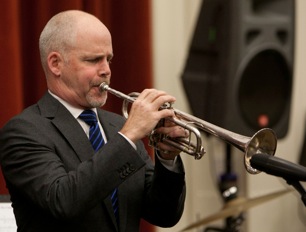 The remainder of Burns’ program consisted of contemporary works which have become the performer’s modus operandi as a soloist. Metallics by Yan Maresz featured Burns performing into a microphone while a prerecorded track was projected through the room. A nearby sound engineer altered the output settings of Burns’ microphone to distort the timbre of the trumpet to reflect a variety of metallic states. In an equally inventive piece by Toru Takemitsu entitled Paths, Burns told the story of two men, a master and an apprentice, walking through a Japanese garden. Though the work was for unaccompanied trumpet, the dialogue between characters was clearly delineated by the use of harmon mute when the apprentice was speaking. Burns executed the frequent and sudden color changes by employing a five-foot tall homemade mute stand wrapped in duct tape. When asked about the collaborative elements involved in performing electronic music, Burns explained the process as being anything but random. “The performer’s understanding of the integration of events has to be incredibly thorough. Like any straight ahead work, there are moments of independence and moments of ensemble clarity that give the piece structure. The soloist has to then work with the sound engineer so that the monitors are balanced correctly so that every cue can be heard. If the balance isn’t perfect, you could miss a cue and play in the wrong spot and then a point of vertical alignment later in the piece is ruined.”
The remainder of Burns’ program consisted of contemporary works which have become the performer’s modus operandi as a soloist. Metallics by Yan Maresz featured Burns performing into a microphone while a prerecorded track was projected through the room. A nearby sound engineer altered the output settings of Burns’ microphone to distort the timbre of the trumpet to reflect a variety of metallic states. In an equally inventive piece by Toru Takemitsu entitled Paths, Burns told the story of two men, a master and an apprentice, walking through a Japanese garden. Though the work was for unaccompanied trumpet, the dialogue between characters was clearly delineated by the use of harmon mute when the apprentice was speaking. Burns executed the frequent and sudden color changes by employing a five-foot tall homemade mute stand wrapped in duct tape. When asked about the collaborative elements involved in performing electronic music, Burns explained the process as being anything but random. “The performer’s understanding of the integration of events has to be incredibly thorough. Like any straight ahead work, there are moments of independence and moments of ensemble clarity that give the piece structure. The soloist has to then work with the sound engineer so that the monitors are balanced correctly so that every cue can be heard. If the balance isn’t perfect, you could miss a cue and play in the wrong spot and then a point of vertical alignment later in the piece is ruined.”
When discussing how to begin performing with electronic music, Burns had some simple advice for where to begin. He explained that fairly inexpensive equipment could be purchased that was capable of looping and distorting sound. By recording a loop of one’s own sound, the player can practice playing simple exercises and improve intonation and rhythmic control in the process.
After a prelude performance by the Kentucky Baroque Trumpets, Carl Saunders gave the final concert of the day with an area combo featuring Phil DeGreg on piano, Michael Sharfe on bass, and Art Gore on drums. The program featured many of Saunders’ own original tunes combined with a few standards like Dizzy Gillespie’s I Can’t Get Started.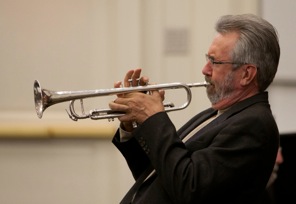
The entirety of the day’s events were captured on video by Dr. Raquel Rodriquez, Assistant Professor of Trumpet at Northern Kentucky University and will be edited into brief educational segments available soon through the International Trumpet Guild Website. Dr. Rodriquez will host next year’s OITG meeting, date forthcoming.
Source: Tim Dailey, DMA Candidate, University of Cincinnati – College Conservatory of Music, James Olcott
Take advantage of what ITG has to offer: JOIN ITG